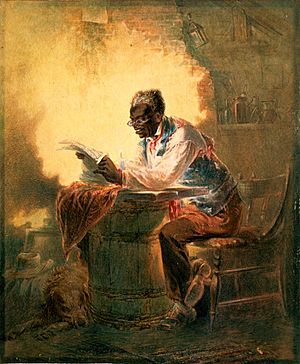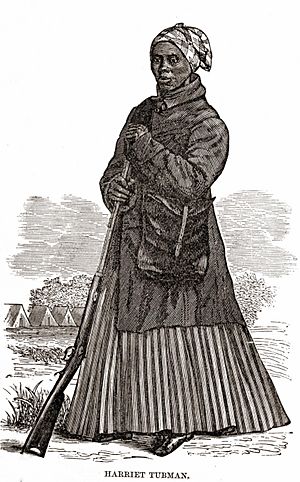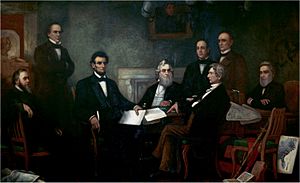Slavery during the American Civil War facts for kids
The role of slavery was central to the American Civil War. The main reason the Southern states broke away was to protect slavery. Southern leaders especially wanted to stop Northern groups from stopping slavery from spreading into new western areas. Life for enslaved people changed a lot as the Union Armies took control of large parts of the South. Both before and during the war, enslaved people actively worked to free themselves. Thousands escaped from slavery during the conflict.
Contents
Slavery's Role in the South
In 1860, only a small number of people in the U.S. owned enslaved people. Most enslaved workers in the South were held by "planters," who owned twenty or more people. These planters were fewer than 50,000, but they controlled much of the South's wealth.
Southern farming was very profitable. It focused on crops like rice, cotton, and sugar. In some areas, like parts of Georgia, South Carolina, and the Mississippi Delta, there were ten or even twenty enslaved black people for every white person. This difference grew during the war. It made slave owners fear uprisings and led to calls for local militias to keep order.
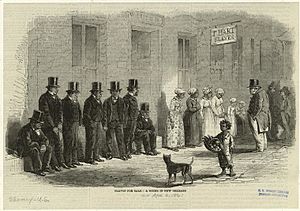
The buying and selling of enslaved people continued during the war. People also rented out enslaved labor. The price of enslaved workers went up, but not as fast as other prices. This meant the real value of enslaved people actually went down during the war. Their prices often changed based on how well the Confederate side was doing in the war. Before the war, expanding slavery was a key goal for slaveholders. This continued during the war, with slavery spreading into Texas. However, late in the war, many slave owners realized slavery might end. They tried to sell the people they enslaved more often.
Culture and Life Changes
How African American Culture Changed
Enslaved people gained more freedom during the war, which led to new ways for them to express their culture. Christianity became more popular among enslaved and newly freed people during and after the war. Groups like the American Missionary Association sent people to Union-controlled areas. They started churches and led religious gatherings. The African Methodist Episcopal Church (AME) became very important among enslaved and freed people. The AME also provided chaplains for black Union regiments.
Music sung by African Americans also changed during the war. Songs about escaping slavery became very important. Enslaved people sang these songs among themselves on plantations. Free and newly freed black people also sang them for white audiences. New versions of songs like "Hail Mary" and "Go Down Moses" focused on freedom and rejecting slavery. Many new songs appeared, with "Many Thousands Go" being very popular. Enslaved people often sang it when fleeing plantations to Union Army camps.
White officers noticed these changes. Colonel Thomas Wentworth Higginson of the all-black First South Carolina Colored Volunteers saw that black people changed their songs when white people were listening. Historians say African Americans used music to change how white people saw their culture. In Port Royal, escaped slaves secretly learned the song "America." They never sang it in front of white people. When the Emancipation Proclamation was announced, they celebrated by singing "America." This surprised white onlookers and showed their new status.
Slave owners in the South tried to stop this. They limited singing on plantations. They even imprisoned people who sang songs supporting freedom or the North. Some Confederate bands included enslaved musicians. Confederates also made enslaved people sing and dance to show they were happy.
White People's Views on Slavery
Historians have also studied what white people thought about slavery during this time. Generally, poor white people in the South who didn't own slaves often looked up to planters. They hoped to own slaves themselves one day. Confederate soldiers were hopeful that the Confederacy and slavery would survive well into 1864.
Confederates feared the Emancipation Proclamation would cause slave uprisings. Even Northerners did not want this to happen. Most people at that time had not been alive during the Nat Turner Revolt or the revolution in Haiti, but they still greatly feared rebellions. Also, the North was not fully against slavery. Many Union soldiers wanted the U.S. to remain a white man's country, no matter who won. However, everyone knew that Lincoln's party, the Republican Party, wanted slavery to end eventually, if not right away.
Historians agree the war started over slavery. But the role of slavery in motivating soldiers has been debated. Some historians say Confederate soldiers didn't think much about slavery. Others argue that slavery was very important to many Confederate soldiers. The importance of slavery for Union soldiers has also been discussed.
Resistance to Slavery
Slave uprisings were a constant fear for slaveholders before and during the war. In the summer of 1861, a slave uprising was planned in Adams County, Mississippi. It was discovered, leading to harsh punishments for enslaved people there. Other planned uprisings also occurred in Louisiana and Jefferson County, Alabama. Slaveholders in mountainous areas were especially worried because the land made it harder to watch the people they enslaved.
Physical punishment was common in slave society. This included enslaved people working with the Confederate Army, who were often whipped. Sometimes, enslaved people were rewarded for good behavior. But many believed punishment was better for control. Punishments could include hurting someone, murder, or selling loved ones. Selling family members was often seen as one of the worst punishments.
How Enslaved People Resisted
Enslaved people resisted slavery in many ways before and during the Civil War. This resistance affected Southern soldiers' morale. It showed that black people were not loyal to the Confederacy. Generally, African Americans wanted the Union to win. The Confederacy tried hard to keep enslaved people under control. After the war, Confederate veterans often said their enslaved people were loyal. But in reality, resistance was common.
On farms and plantations, enslaved workers broke tools, pretended to be sick, worked slowly, stole, planned revolts, and ran away. Both white and black people helped those escaping slavery through the Underground Railroad. This made people like Harriet Tubman famous. Slave owners were very upset when enslaved people fled to Union armies. Many truly believed enslaved people were loyal. They blamed anti-slavery ideas and the enslaved people's supposed ignorance about freedom's costs for their desire to escape.
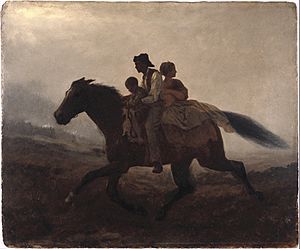
The number of runaways during the war varies in estimates. Some historians believe between 500,000 and 1,000,000 enslaved people escaped. Enslaved people often hid their true feelings from their masters. They wanted to appear loyal but waited for a chance to be free. Some were willing to risk their lives and families, while others were not. Many enslaved people remained on plantations, especially in the early war years. Escaping slaves who were caught were usually treated very harshly and often killed.
When Union armies advanced, many slave owners fled and took their enslaved people with them. But in areas where the Union moved quickly, like along the Atlantic coast, slave owners left their enslaved people behind. Many of these people then escaped to the Union side. Slave owners fleeing from Louisiana and Mississippi often went to Texas. Roads to Texas were said to be full of planters moving with their enslaved people.
Confederates often talked about the negative sides of freedom to their enslaved people. Letters from captured Confederate soldiers described the poor living conditions of freed people in Union-held cities. Indeed, disease and lack of medical care were big problems in Federal camps for freed people. Some former slaves were sent to local planters where conditions were better. There were also cases of harsh treatment and social problems among freed people in Federal hands.
Despite clear evidence that enslaved people wanted to be free, the idea of the "loyal slave" became fixed in the minds of many white Southerners during and after the war. This idea had some truth, as some enslaved people stayed due to personal bonds, a sense of duty, or other reasons. There are also stories of enslaved people who served their masters in the Confederate Army, protected women and children from Union troops, or helped elderly or wounded masters when they could have escaped.
Enslaved People in Confederate Service
The Confederacy's early military successes relied a lot on slavery. Enslaved people did farm and factory work, built forts, fixed railroads, and allowed white men to become soldiers. Tens of thousands of enslaved people built and repaired forts and railroads. They also worked as haulers, drivers, ditch diggers, and medical assistants. In these roles, enslaved people in the army were heavily relied on and sometimes overworked to the point of sickness or death.
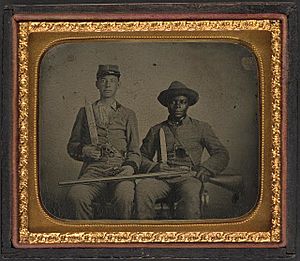
Another role enslaved people played was as camp servants. This was more common in large armies than with local guards. Camp servants served their master, not the government. They served officers and regular soldiers. Most Confederates could not afford this, but it was not rare. Sometimes, enslaved servants were paid or kept part of their earnings.
Confederates often wrote about how enslaved people cared for their dying or dead masters. They saw this care as proof of a good relationship between masters and enslaved people. Historians have questioned if this care was truly affection or if it was due to worry about their own future after their master's death.
The role of slavery in the size of the Confederate Army was complex. Using enslaved labor in camps freed white soldiers to fight. But people were said to be more willing to send their white men to the army than risk the lives and labor of their enslaved people. In October 1862, the Confederacy passed the "Twenty Slave Law." This law allowed one white man to stay on plantations with twenty or more enslaved people. It was meant to protect property but also angered many non-slaveholders in the South.
Forced Labor (Impressment)
The Confederate Congress passed a law on March 26, 1863, allowing them to force enslaved people into labor. This raised questions about whether they could also seize free black people. In 1860, about 260,000 free black people lived in the South. Virginia's government made free black people subject to the Confederate draft for non-combat roles. They also limited how many enslaved people the government could force into service. So, commanders in Virginia could force both free and enslaved black people into service. However, only a small number of free black people were actually forced into service. This was partly because few free black men were of military age, and many were already doing military-related jobs.
Early in the war, Confederate soldiers were generally comfortable. But by spring 1864, things got harder. On March 4, 1864, a Confederate order said officers and soldiers would get only one meal a day, with no extra for servants. Many commanders protested. They asked for more food to feed their servants.
Enslaved laborers faced the dangers of war. Confederates sometimes wrote about enslaved workers facing enemy shelling. While slave owners expected payment if their enslaved people died serving the Confederate Army, most Confederates did not own slaves. They preferred a dead black worker over a dead white one. So, the dangerous conditions for enslaved labor might have been planned.
Sometimes, enslaved people on a plantation were asked to volunteer for the army. Some were excited about the change in tasks. However, the Confederacy needed more laborers than enslaved people could provide. This was made worse because white Confederate soldiers often refused to do necessary labor. The Confederate government set up offices to make sure slaveholders provided enough enslaved people.
Confederate forces also raided Union-controlled plantations in the South. When Confederate forces marched North, like during the Gettysburg campaign under Robert E. Lee, they rounded up as many black people as possible in Pennsylvania. This included those who were free before the war. These individuals became part of the spoils of war. Northerners asked camp servants with the Confederate Army why they didn't escape to freedom. It would have been hard for them to escape during the campaign. Also, fleeing North might not have seemed appealing. In some cases, Northerners showed their racism and dislike for black people in front of Confederate soldiers and servants.
Even before the government allowed forced labor, officers made thousands of enslaved people work. The scale of these projects was much larger than on plantations. Enslaved people built forts at Richmond, Fort Henry, Fort Donelson, Island No. 10, Vicksburg, Port Hudson, Wilmington, and Mobile. In September 1862, General P. G. T. Beauregard had 1,400 enslaved people working on forts at Savannah. In May 1862, 7,500 enslaved people were said to be working at Mobile. In spring 1863, between 4,000 and 6,000 enslaved people worked on railways leading into Richmond. This forced labor on forts eventually helped end slavery. It was used to justify laws like the Confiscation Acts and later the 13th Amendment.
Near the end of the war, enslaved people were greatly needed to build up the last Confederate strongholds. In defending Atlanta, General Joseph E. Johnston asked for 12,000 enslaved people to join his army as drivers and cooks. But such a large number was never provided. Still, enslaved people were important in the campaign, building defense lines for the Confederate army. At Richmond, Lee received 2,000 of his requested 5,000 enslaved people to replace white drivers, allowing them to fight.
Near the end of the war, the Confederacy tried to enlist black soldiers. In November 1864, Confederate president Jefferson Davis asked Congress to buy 40,000 enslaved people. They would then be freed if they served in the military. This idea caused a lot of debate in the South. General Patrick Cleburne was a strong supporter of arming enslaved people. Opponents included General Howell Cobb, who argued in January 1865, "If slaves will make good soldiers our whole theory of slavery is wrong." As the Confederacy fell apart in early 1864 and 1865, arming enslaved people became, in the words of General Robert E. Lee, "not only wise but necessary." In March 1865, Davis allowed black people to join the Confederate army. Companies began to form by March 25. However, Confederate forces in Virginia surrendered on April 3, and the war ended on April 9, 1865. This happened before black soldiers had a chance to fight for the Confederacy.
Contraband and Freedom
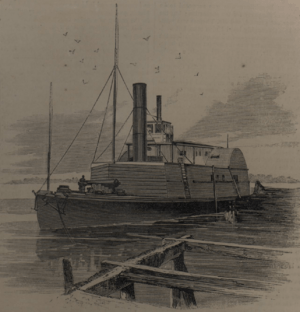
At the start of the war, Abraham Lincoln hoped to keep the United States together, with or without slavery. Early on, Union Generals were hesitant to help escaping enslaved people. But by 1862, the war became more intense, and Union forces began to seize enslaved people seriously. As early as May 1861, Union General Benjamin F. Butler at Fort Monroe, Virginia, refused to return escaped enslaved people to their owners. Butler used them for army work. He argued that returning them would help the enemy. The Grand Contraband Camp, Virginia was formed for these people.
Lincoln allowed Butler's policy to continue. On August 6, 1861, Congress passed the First Confiscation Act. This law allowed the government to seize any property used by the Confederacy, including enslaved people. However, Union commanders were officially told to keep runaway slaves out of their lines until July 1862. Then, Lincoln admitted that allowing enslaved people to escape to Union lines was a military necessity.
The escaped enslaved people became known as "contrabands." Over 200,000 of them came to work for the Union Army. At first, contrabands did basic jobs like driving wagons, cooking, and laundry. As the war went on, many contrabands took on more formal jobs supporting the Union Army. Lincoln feared the 1861 Confiscation Act would push Border States into the Confederacy. He also opposed efforts by Generals like John C. Fremont to push for emancipation and enlist black soldiers.
Some Union Army Generals, especially Democrats, continued to return escaped enslaved people to their masters. General Henry Halleck's order even banned runaway slaves from his lines.
However, enslaved people strongly wanted to be free and help themselves gain freedom. Black people were key in creating anti-slavery feelings in the North. Union soldiers saw the scars on the bodies of enslaved people they met. They saw the poor conditions they lived in. They heard their stories and saw their willingness to fight for their own freedom and join the Union Army.
This desire to fight was very appealing to Union Generals who needed more soldiers. Since 1792, federal law had stopped black men from serving in state militias and the U.S. Army. But that changed during the war. In May 1862, General James H. Lane in Kansas and John W. Phelps in Louisiana began to enlist black men into regiments without official permission. Lane's efforts led to the First Kansas Colored Volunteers. Phelps was first opposed by his superior, General Butler. But Butler, desperate for more soldiers, gave in by August 1862. This led to the Louisiana Native Guards, mostly made up of free black men.
Also in May 1862, General David Hunter declared military rule and ordered enslaved people freed in the area around his command in Georgia. This area included parts of coastal South Carolina, Georgia, and Florida. On May 19, Lincoln canceled Hunter's freedom order. But he said nothing about Hunter's plan to enlist enslaved people. Among the few black officers in these early regiments were free men William D. Matthews and Caesar Antoine.
In September 1862, Secretary of War Edwin Stanton allowed General Rufus Saxton to arm black people to help guard coastal plantations. Saxton had taken Hunter's position. This led to the First South Carolina Colored Volunteers in 1862. It also led to the creation of colonies for freed people in places like Edisto Island and Port Royal. Hunter's recruitment of black people was debated in Congress. Lincoln's quiet support for freeing and enlisting enslaved people, while publicly rejecting Hunter and Fremont, led to criticism from many who wanted slavery ended, like William Lloyd Garrison.
Emancipation and Its Impact
Efforts by the President and Congress to end slavery began early in the war. In November 1861, Lincoln suggested a plan to pay slave owners to free enslaved people in Delaware. Delaware's government rejected this. Lincoln proposed similar plans again in early 1862. He thought it would be cheaper than continuing the war. These plans were rejected again. A third attempt was made on July 12, 1862, but Border State representatives again said no to Lincoln's plan.
In March 1862, Congress passed a law that went around many of the Fugitive Slave Laws of 1793 and 1850. In April, Congress ended slavery in Washington D.C. They paid slaveholders and offered money to help enslaved people move to Haiti or Liberia. In June, Congress freed enslaved people in Federal territories without paying their owners. This overturned the Dred Scott v. Sandford decision of 1857.
After his plans for paying slave owners were rejected repeatedly, Lincoln began to think about a presidential order to free enslaved people in mid-1862. On July 17, 1862, Congress passed the Militia Act. This law freed Confederate enslaved people working for the Union army. It also allowed the president to use black people for "any military or naval service." This allowed black people to join the army, though it was meant only for enslaved people of disloyal owners, not free black people or enslaved people of loyal Border State owners. That same day, Congress passed the Second Confiscation Act. This law allowed the freeing of enslaved people owned by people fighting against the Union. Lincoln was slow to use this law, which led to criticism from people like Frederick Douglass.
On July 21, 1862, Lincoln told his cabinet he planned to use the military and freedom parts of the new laws. He would not include the idea of moving freed people to other countries. The next day, he shared the first draft of the Emancipation Proclamation with his cabinet. His plan would free enslaved people even beyond areas controlled by the Union. It would be a war measure, which meant it could bypass courts and lawmakers. To avoid upsetting the Border States, especially Kentucky, Lincoln waited until the New Year to announce his plan. He also wanted to wait until the Union Army had made some progress. This would make sure the proclamation didn't look like an act of desperation.
McClellan's victory at the Battle of Antietam in late summer 1862 gave Lincoln the political power he needed. This was important for him to issue his Emancipation Proclamation. People who wanted slavery ended, like Frederick Douglass, greatly approved of Lincoln's new stance. Douglass wrote, "The white man is liberated, the black man is liberated, the brave men now fighting in the battles of their country against rebels and traitors are now liberated..."
The proclamation did receive some criticism, especially from the South. It only freed enslaved people in Confederate-controlled areas. It did not free about 800,000 of the country's 2.9 million enslaved people. Also, its success depended on Union victories in the war. General William T. Sherman was among those who opposed it, but he still followed the orders.
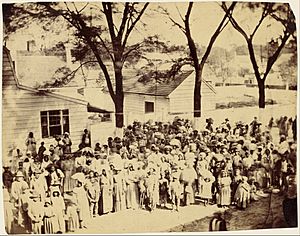
Throughout the war, enslaved people were freeing themselves. Two main things helped them choose freedom. First, it became easier to escape as white men who controlled enslaved people left plantations to join the Confederate Army. Second, Union troops advanced closer. To stop escapes, attempts were made to better organize slave patrols. But these were less effective because experienced slave owners were often away fighting.
The Union Army's advance greatly affected slavery in the areas they took control of. The first region the Union Army captured was the Sea Islands off the coast of South Carolina and Georgia. Confederates reported that after their masters fled, the enslaved people in those areas took their masters' property. The Union also gained ground in western Kentucky, western Tennessee, and northern Mississippi.
Union forces tried to help freed enslaved people. In Tennessee, General Ulysses S. Grant put John Eaton, Jr. in charge of runaways. A camp was set up at Grand Junction, Tennessee, later moved to Memphis. This camp provided shelter, food, and some medical care. It also helped freed people find jobs with white people who leased abandoned plantations. This changed farming in Union-held areas from slave labor to paid labor. This system had already been used in 1862 along the South Carolina coast in the Port Royal Experiment.
These efforts were not always successful. There were problems between wanting things to be efficient and wanting black people to have control over their own lives. In some places, like on Jefferson Davis's properties at Davis Bend, Mississippi, freed black people were given land and direct control. But despite these examples, most freed enslaved people became paid laborers. This was more like sharecropping than true freedom. This failure to give freed enslaved people a strong economic start is seen as a reason why Reconstruction failed.
Black Soldiers in the Union Army
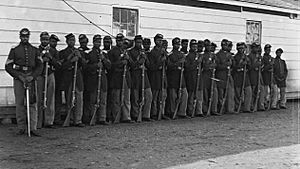
After the Emancipation Proclamation, black soldiers became common. Eventually, 178,895 black men served, with 133,000 coming from slave states. Most of these were formerly enslaved people. Northerners were at first uncomfortable arming black people. Black troops were usually led by white officers. They also received worse equipment and medical care. They were given a lot more heavy labor. However, the success of these regiments changed people's minds.
The Confederate government and army were very angry about the North using black soldiers. They saw these troops as a slave uprising. They treated captured black soldiers by re-enslaving them or executing them for treason. In December 1862, Jefferson Davis issued what was called the "Anti-Emancipation Proclamation." It stated that the Confederate Army would return any black man found in a Federal uniform to slavery. Any enslaved people found helping Northern units would be turned over to the states. The same would happen to white officers of black regiments. This led Lincoln to threaten to kill a captured rebel soldier for every black Union soldier killed in captivity. He also said that every captured black soldier sent back to slavery would result in a Confederate captive being given hard labor. No official retaliation of this kind actually happened.
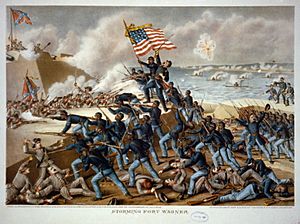
Black troops were not seen as equal by either Union or Confederate forces. Black soldiers often faced harder conditions and had worse medical care. The death rate for black soldiers was about 40% higher than for white troops. Over 38,000 black soldiers died from all causes. On the battlefield, black soldiers fought well. They earned the respect of both Union and Confederate troops. However, Confederate victories against black soldiers sometimes led to terrible acts. Surrendering black Union soldiers were executed by Confederates. Two of the most famous examples were in 1864 at the Battle of Fort Pillow in Tennessee and the Battle of the Crater in Virginia. At these battles, black soldiers were killed at a much higher rate than white soldiers.
After the War
At the start of 1865, millions of black people were still enslaved. But the system of slavery was falling apart. As the Confederate Army grew weaker, the Confederacy's ability to control enslaved people lessened. Large numbers of enslaved people escaped to Union lines every day. Even as the large armies surrendered, some Confederates still hoped for victory and for slavery to return throughout the South. At the war's end, some white Southerners fled to South America. There, they could escape U.S. law and, in some cases, continue owning enslaved people. But these cases were rare.
Enslaved people saw freedom as more than just the end of slavery. They also wanted education, voting rights, and equal rights under the law. The 13th Amendment, passed in January 1865, ended slavery in the Union. It made sure that all enslaved people in the South would be freed under U.S. control.
After the war, a story of "faithful slaves" became popular in the South. These stories told of enslaved people marching with their masters or celebrating soldiers returning to plantations. Black people living in the South were no longer enslaved, but most stayed and worked for their former masters. Even so, racial tensions grew greatly during the Reconstruction era. White supremacy also grew. This was seen in the rise of groups like the Ku Klux Klan and the Lost Cause of the Confederacy movement. The KKK was a radical group that harmed African Americans and their supporters.


